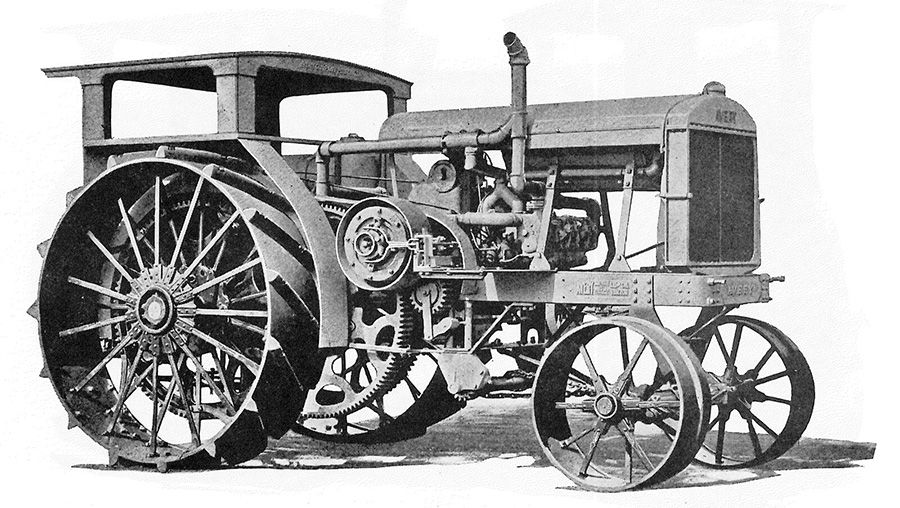The story of the little-known Avery Company is a near-miss tale of a firm that did everything right but at the wrong time. Avery falls into that category of a very promising endeavor that could have become a major power in farm machinery. Instead, it hit economic roadblocks that, in time, brought it down.
In its day, Avery was a firm to be reckoned with. The company’s line was extensive, featuring not only steam traction engines, tractors, and farm implements (its threshers were considered some of the best built at the time) but also road-building and construction vehicles, as well as trucks.
In the early 1900s, Avery was no small thing, having built the largest tractor manufacturing facility in the world (its claim). The property covered 27 acres.
The founding genius of the company was Robert Avery, who had a penchant for inventing. While he was imprisoned in the infamous Confederate Andersonville Prison, Avery passed his time in confinement devising a seed drill by sketching his concepts in the sand.
After the war, he farmed with his brother, John, near Galesburg, Illinois. During this time, he worked on several inventions, one of which came to be in a riding cultivator.
Avery’s brother, Cyrus, recognized the potential in Robert’s design. So they joined forces to build it. However, their firm, the first Avery Company, floundered, teetering on bankruptcy. Robert moved to Kansas to farm.
Wisconsin Historical Society
Continued To Invent
When not farming, he set about building a better corn planter and then a thresher. This time, his inventions attracted buyers. So Avery moved back to Illinois, teamed up with brother Cyrus, and set to work manufacturing. This second Avery company grew rapidly and eventually moved to Peoria, Illinois, while expanding its product lines to include stalk cutters, cultivators, and hand tools.
At that time, 1883, what was known as Avery Planter Company was capitalized at $200,000. Sales success catapulted the firm’s worth to $600,000 in just six years. By 1891, Avery Manufacturing grew to include steam traction engines and threshers.
Despite the death of Robert in 1892, the firm continued to grow and gain a reputation for innovation. Soon much of the creative energy of the firm was focused on internal combustion engines. In 1909, Avery began building tractors to meet the growing power needs of sod-busting plows opening up the High Plains.
The firm, which by this time was worth well over $1 million, set out to be a major player in horsepower. By 1912, the Peoria facility had grown to cover more than 27 acres, and the equipment line expanded to include wagons, steam shovels, all sorts of cultivators and harvesting equipment, trucks (three different models), and, of course, tractors.
What set Avery apart from other tractor manufacturers at this time was the firm’s devotion to engineering advances.
Wisconsin Historical Society
Known For Innovation
Improved engineering allowed Avery’s extensive line of tractors to grow in power but shrink in size. This made them popular in the Corn Belt. Avery had acquired an engine plant in 1917 and utilized it to build advanced power plants featuring such pioneering advances as renewable cylinder sleeves, crankshaft and piston rod bearings, cellular radiators, and sliding gear transmissions.
At this time, 1920, Avery Company was led by J.B. Bartholomew, whose operation had grown to employ 4,000 people. Bartholomew was a pioneer in the development of motor cultivators, which enjoyed brief success in the late 1910s.
Wisconsin Historical Society
WWI Depression Hits
The post-World War I depression hit, and Avery Company was deeply in debt due to its rapid expansion. In response, the company slashed its workforce by 90%. Such economizing failed to save the company, and it went into receivership in 1923.
A year later, Bartholomew died.
From the ashes of that failure emerged a new firm formed by former officers of the company. Renamed Avery Power Machinery Company, the reborn company continued operating out of Peoria and went on to develop and built a new line of advanced all-steel threshers and combines that employed such advances as anti-friction bearings. Tractors were also in the offering. Four models ranging from 15 to 65 hp. were built along with various road-construction vehicles and a single truck model.
Wisconsin Historical Society
Its advanced machinery could not save Avery from the Great Depression. Banks with interest in the company placed it under a manager who gradually liquidated its assets.
However, one last attempt was made to revive the proud name. Avery Farm Machinery Company emerged in 1936 selling primarily combines and separators but just one tractor, the Avery Ro-Trac. This very modern tractor featured an unusual front axle that could be readily converted from a narrow (for row cultivation) to a wide stance (for tillage).
World War II interrupted this last attempt at revival, and the company closed its doors for the last time.
